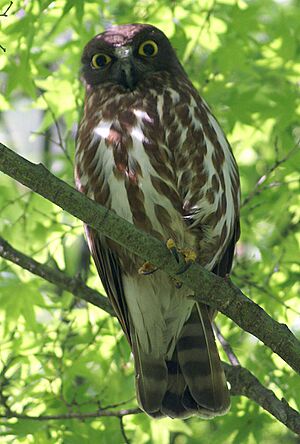Northern boobook facts for kids
The northern boobook (Ninox japonica) is a type of owl that belongs to the family called Strigidae, also known as true owls. These cool birds of prey live in eastern and southern parts of Asia. For a long time, scientists thought the northern boobook was the same as the brown boobook (Ninox scutulata). But now, they are considered different species.
The northern boobook has two main groups, called subspecies: Ninox japonica japonica, which travels long distances, and Ninox japonica totogo, which stays in one place. Even though it's a common owl in Japan, we still have a lot to learn about it. Scientists believe there aren't many fewer northern boobooks around, so its conservation status is listed as least concern by the IUCN Red List.
Quick facts for kids Northern boobook |
|
|---|---|
 |
|
| Conservation status | |
| Scientific classification | |
| Genus: |
Ninox
|
| Species: |
japonica
|
| Subspecies | |
|
|
| Synonyms | |
|
Ninox scutulata japonica |
|
Contents
What Does the Northern Boobook Look Like?
The northern boobook is a hawk-like owl. It is about 29 to 33 centimeters (about 11 to 13 inches) long. Its wings can spread out to about 60 to 70 centimeters (about 24 to 28 inches) wide. These owls usually weigh around 168 grams (about 6 ounces). Male and female northern boobooks look very similar.
They have brown backs and wings. Their tail feathers have lighter brown stripes. The neck, head, and face are a slightly grayish-brown color. There's a small white patch right above their beak. One of their most striking features is their bright yellow-gold eyes. They also have a black beak and yellow claws, called talons. Their belly is mostly white with some rust-colored spots. These spots are similar to those on their close relative, the brown boobook.
Where Do Northern Boobooks Live?
Northern boobooks mostly live in forests that lose their leaves in the fall. They like places with lots of thick plants and trees. They usually build their nests high up in trees, where they are very hard to see. These owls rarely use the same nest site twice. You might also spot them in wooded parks, gardens, and even in neighborhoods.
In winter, they often fly to warmer rainforests south of their summer homes. Sometimes, they can also be found in mixed forests or evergreen forests.
The northern boobook lives across Siberia and most of Southeast Asia. The subspecies that migrates, N. j. japonica, covers most of this area. The other subspecies, N. j. totogo, lives all year round in the Ryukyu Islands and Taiwan.
For example, N. j. japonica often spends winter in Vietnam, Malaysia, Thailand, and the Philippines. They breed and spend their summers in southern and central China, Korea, Japan, and Siberia. Sometimes, both types of northern boobooks can be found in Taiwan at the same time.
How Northern Boobooks Behave
What Do Northern Boobooks Eat?
The northern boobook is a hunter that eats many different things. They mainly eat small animals without backbones, like insects. Sometimes, they also eat small animals with backbones, like small birds. Very rarely, they might catch lizards or bats.
These owls hunt at night. They like to sit on a high branch and watch for prey. Once they spot something, they swoop down to catch it in the air or from the ground.
Life Cycle and Reproduction
Male northern boobooks of the N. j. totogo subspecies start looking for breeding spots as early as January. They find a female partner by February. During this time, the owl pairs are often seen together and make more sounds. This behavior usually means they are getting ready to have babies.
The female owl lays about 3 or 4 eggs. She sits on them alone for about 28 days. This usually happens from early March to early April. The young owls stay in the nest for about 26 days before they are ready to fly. This happens in May.
The northern boobooks that migrate, N. j. japonica, usually don't start breeding until April. Their breeding season is shorter, lasting about 4 months. The N. j. totogo subspecies has a longer breeding season, lasting about 5 months.
How Northern Boobooks Vocalize
Northern boobooks make a sound like a deep "ho-ho." They usually only make these sounds when they are breeding. This means you won't often hear a northern boobook calling in places where they only visit for winter.
Conservation Status
There are no signs that the number of northern boobooks is going down around the world. Because of this, their conservation status is listed as "least concern" by the IUCN Red List. However, scientists still don't have a lot of information about how many northern boobooks there are across all the places they live.


